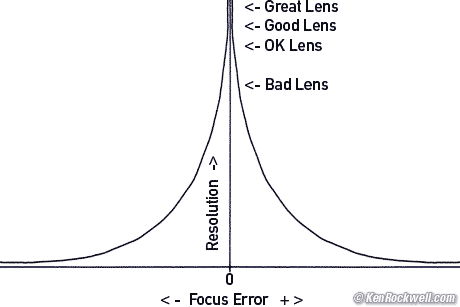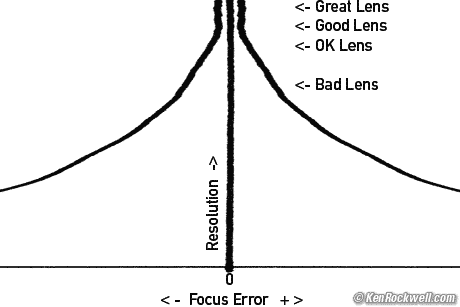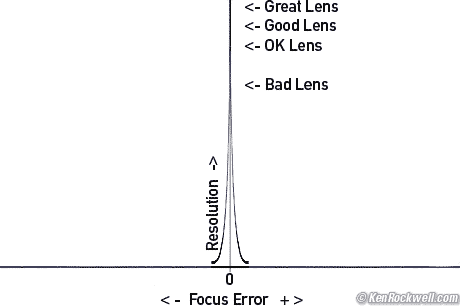I get my goodies
at Amazon and Adorama.
It helps me publish this site when you get yours from
those links, too.

Middle Aperture

Small Aperture - lots of room for error

Large Aperture - no room for error
INTRODUCTION
Focus errors limit resolution at larger apertures more than the differences between lenses.
In real photography one never gets the full resolution of which large aperture lenses are capable in lab tests.
At large apertures like f/1.4 and f/2.0 you'll miss most of the performance of which your lens is capable if your cameras and eyeballs aren't well calibrated, even for flat, fixed subjects.
SPECIFICS
The graph shows the maximum possible resolution based on the accuracy of your focus. It's exactly like depth-of-field. If I wasn't so lazy I would have drawn a few different graphs, instead I stretched and squeezed my hand-drawn graph in Photoshop, so please excuse the fat wiggly lines in the one graph.
Perfect resolution only happens with perfect focus. No matter how good your lens, if your focus is just a little bit off your resolution plummets.
Just like depth of field, this is much pickier at larger apertures.
At larger apertures, even small amounts of defocus make all lenses have the same performance. This is why Zeiss and Contax and the Germans do funny things like design cameras with vacuum film backs to hold film flat.
Most subjects aren't flat so you can't get perfect focus on your entire subject. This only matters for testing lenses and for spy satellites.
PRACTICAL APPLICATIONS
Auto and manual focusing is only so accurate. It's fine for small apertures like f/5.6, OK for f/2.8, and usually at it's limits at f/2.0.
When I run tests I make many shots at slightly different focuses to ensure I catch the perfect focus. This isn't important with f/5.6 zooms, but critical with f/1.4 primes.
Back in film days I had to custom calibrate each of my Nikons so the image on film matched what I saw through the finder at f/1.4. It made no difference at f/2.8, but made a world of difference at f/1.4. At f/1.4 the depth of field is so paper-thin that the region of sharpness rarely was where I wanted it.
Manual focus is even sloppier on digital SLRs. Today Nikon only has a single dot that lights up when you're sort of in focus. In the older days Nikon had two or three lights with arrows to tell you when you were as exact as it could measure. Today the green dot is only "close enough," not perfect. Think about it: if the dot only lit when you were perfect, it would almost never light and you'd focus right past it! The dot is OK for slow f/5.6 zooms, but too sloppy for f/1.4 primes.
In my 50mm lens comparison it became painfully obvious that the range of focus over which the "in focus" dot lit on my Nikon D200 was too broad for f/1.4 lenses. It also wasn't perfectly calibrated. I discovered that I got best focus when I turned the focus ring slowly towards closer distances, and stopped right as the dot was on the hairy edge between off and on on the closer side.
RECOMMENDATIONS
Don't worry about your lenses' sharpness. The lens designers already have. The lenses you already have are all you need.
See my article Your Choice of F/Stop Is Far More Important Than Your Choice of Lens for a page of examples.
Worry about getting interesting places and making great photos!
PLUG
If you find this as helpful as a book you might have had to buy or a workshop you may have had to take, feel free to help me write more with a donation.
Thanks for reading!
Ken
Next: 50mm Lens Sharpness Comparisons


